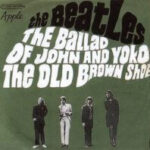The world still mourns the loss of John Lennon, a musical icon whose songs of peace and love resonated across generations. Even decades after his death, his music continues to inspire, as evidenced by the recent emotional release of the Beatles’ final song, “Now and Then,” utilizing a demo he recorded shortly before his passing. But Lennon’s life was tragically cut short. On December 8, 1980, the world was shocked by the news of his assassination. But why was John Lennon assassinated? The answer lies in the disturbed mind of a fan turned killer, Mark David Chapman.
The Day Tragedy Struck: December 8, 1980
Mark David Chapman’s path to infamy culminated on December 8, 1980, a day that began with chilling premeditation. This wasn’t Chapman’s first foray to New York City in search of Lennon; it was his second trip in under two months. He had previously scouted the Dakota, the iconic Upper West Side apartment building where Lennon lived with his wife Yoko Ono, observing the doormen and familiarizing himself with the location, as detailed in Jack Jones’ book “Let Me Take You Down,” based on extensive interviews with Chapman.
Mark David Chapman’s mugshot after his arrest for the murder of John Lennon, capturing the face of the man who ended a global icon’s life.
Chapman arrived in New York on December 6 and checked into the West Side YMCA, a mere ten-minute walk from the Dakota. For days, he lurked outside the Dakota, mingling with other Beatles devotees. On December 7th, he persisted in his vigil from morning till noon, hoping for an encounter, but Lennon remained elusive.
December 8th was different. Chapman arrived at the Dakota around 9:30 a.m., his resolve hardened. Before leaving his YMCA room, he meticulously arranged his belongings, a grim ritual signifying his conviction that this was the day. Lost in the pages of “The Catcher in the Rye,” a book he considered his personal bible, Chapman inadvertently missed Lennon’s exit from the Dakota that morning. Later, he even shared a meal at the Dakota Grill with a fellow Beatles fan, a surreal interlude before the impending tragedy. In an even more unsettling moment, he encountered Lennon’s young son, Sean Ono Lennon, and his nanny, briefly holding the child’s hand and uttering a chillingly ironic statement about traveling from Hawaii to meet him.
A chilling photograph believed to be John Lennon signing an autograph for Mark David Chapman moments before the assassination, capturing the last known autograph Lennon gave to his soon-to-be assassin.
The fateful encounter occurred that evening. As Lennon and Ono left the Dakota, Chapman was there. Incredibly, Lennon signed a copy of his newly released album “Double Fantasy” for Chapman. Yet, Chapman, armed and ready, did not act at that moment. He waited, even telling a photographer he also wanted Ono’s autograph. Later, around 11 p.m., as Lennon and Ono returned home, Chapman unleashed his deadly intent, firing shots at Lennon as he entered the building. Chapman remained at the scene, offering no resistance as he was arrested.
Unmasking the Killer: Mark David Chapman
So, why did Mark David Chapman commit this heinous act? Chapman himself stated his motivation was a twisted quest for fame. A lifelong Beatles fan, Chapman’s admiration morphed into resentment and disillusionment as he fixated on Lennon’s immense wealth and celebrity. In his distorted view, Lennon, the peace activist who sang of “Imagine,” had become a symbol of hypocrisy, embodying a “corrupt and vast enterprise of personal wealth and power,” according to Jones.
Mark David Chapman during one of his parole hearings, where he has repeatedly been denied release, reflecting the enduring impact and severity of his crime.
Adding to this volatile mix was Chapman’s obsessive identification with J.D. Salinger’s novel, “The Catcher in the Rye.” He saw himself as a real-life Holden Caulfield, “The Catcher in the Rye of my generation.” In a bizarre twist, Chapman claimed he murdered John Lennon to “promote the reading of The Catcher in the Rye,” even signing copies of the book and distributing them in prison. This reveals a deeply disturbed individual seeking notoriety through a horrific act, intertwining his warped self-image with the fame of his victim.
Lennon’s Legacy and the World’s Reaction
John Lennon was only 40 years old when his life was brutally taken. Born on October 9, 1940, he formed the band that would become the Beatles at just 16, achieving global superstardom in his early twenties. His untimely death sent shockwaves around the world, plunging fans into grief and disbelief.
The “Imagine” mosaic in Strawberry Fields, Central Park, a poignant and enduring tribute to John Lennon, inviting visitors to reflect on his message of peace and unity.
In the aftermath of the tragedy, a global outpouring of grief solidified Lennon’s status as more than just a musician; he became a martyr for peace and a symbol of lost potential. Across the street from the Dakota, in Central Park, lies “Strawberry Fields,” a 2.5-acre tribute dedicated to Lennon. At its heart is the “Imagine” mosaic, where, daily, musicians gather to play his iconic songs, keeping his music and message alive for generations to come. David Muniz, who has organized musical tributes at Strawberry Fields since 2013, emphasizes that it’s not about money but about honoring Lennon’s legacy and the enduring power of the Beatles’ music.
Conclusion
The assassination of John Lennon was a senseless act driven by the twisted motives of Mark David Chapman. Fueled by a delusional quest for fame, resentment towards Lennon’s success, and a warped identification with a literary character, Chapman stole from the world a voice of peace and creativity. While the question “Why Was John Lennon Assassinated?” can be answered with the motives of his killer, the true legacy of John Lennon lies not in the tragedy of his death, but in the enduring power of his music and message, which continues to inspire hope and peace across the globe.

